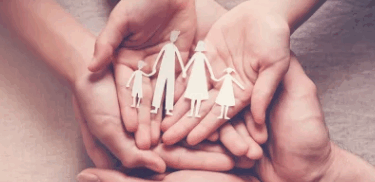Three families share their international adoption stories.
The Internet assures us that we will have access to all information all the time. But that means that we will hear about everything – good or bad – whether we want to or not. That’s why it’s refreshing to read good stories, and ones of adoption are often resoundingly good.
Yet every adoption journey is different. From China, we hear stories of babies abandoned and left in boxes due to the 1979 one-child policy rule. We hear about children having a hard time adapting when they finally come home to their adoptive families. We hear stories of red tape complications, delays and language barriers. And we hear about the emotional roller coaster that can accompany adoption when the waiting game entangles the process.
But what overrides the difficulty in most adoption processes is the result. When adoptive parents finally hold the child they went out of their way to get, it all becomes about love.
Jessie Mei
Steve and Nancy Blake spent six years trying to conceive their first child, Annabelle, so when the desire came to add to their family, they started considering adoption. Should they try to have another biological child, or should they adopt?
“I think that one of the things you’ve got to ask yourselves is whether you’re completely OK with it,” says Nancy. “We had to sit down and have a heart-to-heart. Would we treat [an adopted child] differently? Would we ever not love equally? Our answer was a resounding no. As soon as we realized that, our decision was made.”
When the Blakes ran into roadblocks with a domestic adoption, they began considering international. Nancy lunched with a friend who she knew was adopting a Chinese child. That became significant in determining the direction they would take. It would be China.
The Blakes began working with Chinese Adoption International (chinesechildren.org) on the extensive paperwork and dossier required of adoption-seeking families. They learned the process could take up to two years, but start to finish turned into 15 months for the Blakes.
Referral day finally came. “They call you and tell you the gender, the child’s name (it was Chun Hua Lun, meaning “magnificent logic”), the weight, and then they say, ‘In the next five minutes, you’ll get a photo,'” says Steve. “That was the longest five minutes,” adds Nancy. The email arrived bearing a picture – what the Blakes call a “mug shot” – of their new daughter who they decided to name Jessie Mei. “They matched us with the perfect child,” says Nancy.
It was a month before the Blakes could go get Jessie Mei in China to bring her home. Finally, with older daughter Annabelle in the care of Steve’s parents, Steve and Nancy boarded China Southern flight 328 headed west to Asia. Fourteen hours, several time zones and a crossing of the International Date Line later, the Blakes were finally in their daughter’s native land. And then the process seemed quite easy.
“The handover was really simple,” says Nancy. “They asked what our child’s Chinese name was, and then they handed us our child.” The moments that followed, Nancy says, were filled with 8-month-old Jessie Mei’s blank stares and the sizing up of her new parents.
“Once we got back to the hotel, we played with Jessie, wanting to see some emotion from her,” the Blakes wrote in the blog they kept of their experience. “She kept a blankish stare until she finally had a good pressure releasing cry that lasted five minutes. We saw the light in her eyes by the end of the night.”
The following two weeks brought a visit to Jessie Mei’s orphanage which was “spartan,” according to the Blakes, with wooden mattresses in the cribs. It was emotionally jarring for Steve and Nancy to get a glimpse into their daughter’s beginnings, although they knew the caretakers there really cared for the children. They received a blessing from a Buddhist monk, completed more paperwork and relished the moments with their new little girl. Finally, it was time for the journey home.
After a 10-day stay, Steve returned first in order to prepare big sister Annabelle for her sister’s arrival. He showed “lots of pictures, lots of stories” of baby Jessie Mei who was coming home five days later with Nancy.
At last, feeling complete, the Blakes began settling into life as a family of four. The transition wasn’t so easy for Jessie Mei though, who had a difficult time adjusting to baths and being in her crib.
“She seems to think that if we put her in the crib, we won’t come back,” the Blakes wrote in their blog. “If you heard her terrified and confused screams while in the crib, you would cringe.”
Today Jessie Mei is a gregarious, happy, well-adjusted 4-year-old who is “as integral a part of our family as Annabelle,” says Steve. And, while 15 months may seem a long time to wait, “the process we went through to adopt Jessie Mei was amazing,” says Nancy, “every bit of it.”
Vova
Brad and Tonya Lance and their 3-year-old biological son, Blake, began their adoption experience with Catholic Charities who directed them to a Web site, precious.org. It was there they spotted their future son, Vova, a 9-year-old who was living in the Khukovka Boarding School in Russia. “We saw this boy, and he looked so much like Brad that it was pretty amazing,” says Tonya. “It just seemed right,” she adds.
The Lances contacted the agency that had Vova in its profile – the now closed Reaching Arms International; the Lances ended up adopting independently – and before long Brad was on a plane bound for Russia. “It was the third day in Russia,” says Brad, “and as soon as Vova came in the room, there was no doubt,” he adds. “If we hadn’t already picked him out before we went, I would have hand-picked him there.”
Russian adoptions require a court date followed by a 10-day waiting period for paperwork filing. Tonya accompanied Brad on the second trip for the hearing … but technicalities dictated they say goodbye to their son for the waiting period. Vova was unprepared for this. After the initial hearing, Vova stayed close to Brad and Tonya in their hotel room. Instinctually, Tonya realized that Vova thought he would be staying with them. Unable to communicate – the Lances speak no Russian – Tonya quickly contacted someone who could break the news to Vova. “As he was on the phone, I watched his face go from complete joy to complete sadness,” Tonya says. “I don’t think he exactly understood that we would be back or that he even trusted that we would.”
Ten days later, Brad returned to Russia and brought Vova home. It was wonderful to have their son, but it wasn’t without some growing pains. “His little world had been rocked,” says Tonya. “If you think about it from his perspective, he’s going with two complete strangers to a place where they don’t speak his language, and he’s completely overwhelmed because three years of consistency and normalcy had been taken away from him.”
Vova, who was in the boarding school since the age of 6, was not accustomed to things like car rides and going to church. “He may have gotten into a car once or twice a year,” says Brad, “and I still don’t think he understands why we go to church.” The Lances credit tough love and lots of support in helping Vova – and themselves – adjust.
Fast forward three months, and Vova is ready to jump in the car and go wherever the day make take him. He gets on famously with his younger brother, and he’s making all sorts of new friends at school. And, while his English is still a work in progress, his smile is universal.
Read Nancy Blake’s Adoption Blog!
Cora & Maia
To hear Gretchen Funk of Bellevue tell it, the adoption process can go smoothly or it can be a true test of patience. Gretchen and her husband, Dan, always wanted to adopt. “We always hoped to have two biologically and adopt two,” says Gretchen, “so our family came together the way we hoped it would.”
After having two boys biologically, Dan and Gretchen moved forward with completing their family through adoption. Gretchen, whose father is Portugese, is Spanish-speaking, and she and Dan were drawn to Latin American countries, so when it was time to adopt, they chose Guatemala.
They did their home-study process with Catholic Charities and worked with the agency Special Delivery International. They began with Maia, now 4, shortly after she was born. However, Maia’s birth mother was deaf and mute which brought about lengthy delays. In the midst of lag time, Dan and Gretchen decided to put wheels in motion to adopt another little girl from the same Guatemalan orphanage.
Cora, now 3, was at home with her family by the time she was 5 months old, while Maia remained entangled in a slow court system. “It was awful,” says Gretchen. “For us, having had two biological kids, knowing what we were missing by Maia being in the orphanage … it was very, very hard.”
While the days ticked away for Maia in Guatemala, Cora came home with her new parents to Tennessee. Her older brothers, Joseph and Alex, were immediately fond of their new baby sister. “Alex was in the caregiving role,” explains Gretchen. “He fed her bottles, and Joseph entertained her. It was no different that she was adopted versus biological.”
At last, after two years and nine months, Maia was cleared to join her Tennessee family. Dan, Gretchen and the boys went to Guatemala to get her while Cora stayed at home with an aunt. When they returned with Maia, Cora wasn’t so keen on it.
“She was a little shy at first, and she was sort of careful about the things she did,” says Gretchen, “but she adjusted quickly to the family dynamic.”
In the orphanage, the children call all of the caregivers “Mama,” so when she came home, Maia immediately began calling Gretchen “Mama.” In fact, she called Gretchen’s sister-in-law “Mama,” too. Perhaps one of the most memorable moments for Gretchen was when Maia finally called her – and only her – “Mom.” “It’s like she really got it, she really understood.”
Ashley D. Haugen is a freelance writer.




